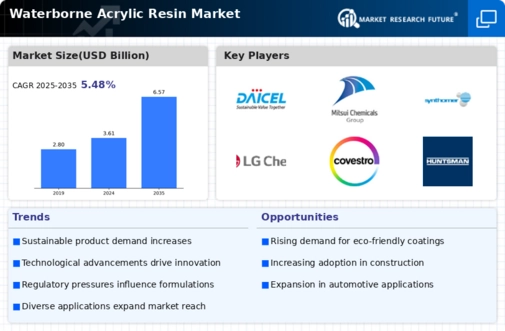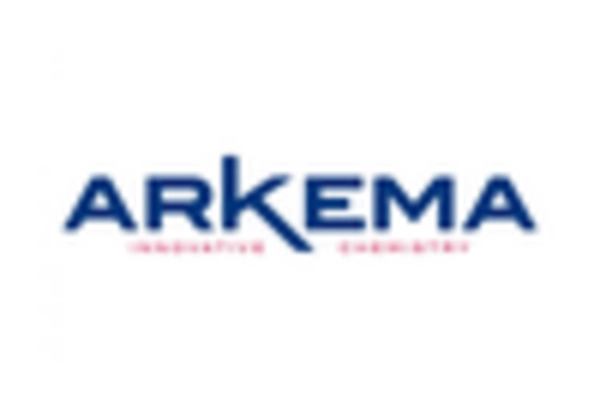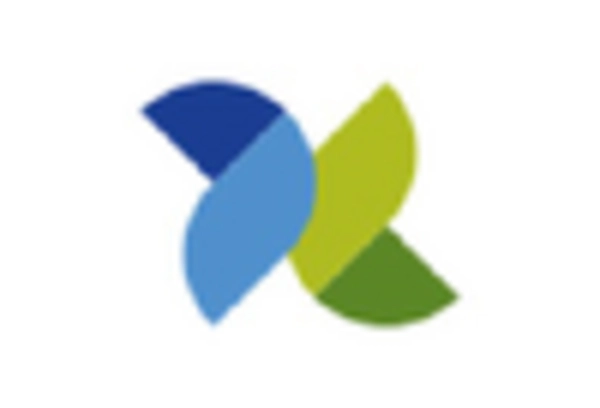Sustainability Focus
The increasing emphasis on sustainability is a pivotal driver for the Waterborne Acrylic Resin Market. As environmental regulations tighten, manufacturers are compelled to adopt eco-friendly materials. Waterborne acrylic resins, known for their low volatile organic compound (VOC) emissions, align with these regulations, making them a preferred choice in various applications. The market is projected to witness a compound annual growth rate (CAGR) of approximately 5% over the next few years, driven by the rising demand for sustainable products. This trend is particularly evident in the automotive and construction sectors, where the need for environmentally responsible materials is paramount. Consequently, companies are investing in research and development to enhance the performance of waterborne acrylic resins, ensuring they meet both regulatory standards and consumer expectations.
Regulatory Compliance
Regulatory compliance is an essential driver for the Waterborne Acrylic Resin Market. Governments worldwide are implementing stringent regulations regarding VOC emissions and environmental safety, compelling manufacturers to adapt their product offerings. Waterborne acrylic resins, which typically have lower VOC levels compared to solvent-based alternatives, are increasingly being adopted to meet these regulatory requirements. This shift not only helps companies avoid penalties but also enhances their market competitiveness. The market is likely to benefit from these regulatory changes, as more industries recognize the advantages of using compliant materials. Furthermore, as regulations continue to evolve, manufacturers are expected to invest in developing innovative waterborne acrylic formulations that align with future compliance standards, thereby driving market growth.
Rising Consumer Awareness
Rising consumer awareness regarding health and environmental issues is significantly influencing the Waterborne Acrylic Resin Market. As consumers become more informed about the impact of chemicals in products, there is a growing preference for low-emission and non-toxic materials. Waterborne acrylic resins, which are perceived as safer alternatives, are gaining traction in various applications, including paints, coatings, and adhesives. This shift in consumer behavior is prompting manufacturers to prioritize the development of eco-friendly products. Market analysts suggest that this trend could lead to a substantial increase in demand for waterborne acrylic resins, with projections indicating a potential growth rate of 5% in the coming years. As awareness continues to rise, companies that align their product offerings with consumer preferences are likely to gain a competitive edge in the market.
Technological Advancements
Technological advancements play a crucial role in shaping the Waterborne Acrylic Resin Market. Innovations in formulation and production processes have led to the development of high-performance resins that offer superior adhesion, durability, and weather resistance. These advancements are particularly significant in the coatings and adhesives sectors, where performance is critical. The market is expected to grow as manufacturers leverage new technologies to create products that meet the evolving needs of consumers. For instance, the introduction of nanotechnology in resin formulations has enhanced the properties of waterborne acrylics, making them more competitive against solvent-based alternatives. This shift towards advanced technologies is likely to drive market growth, with projections indicating a steady increase in demand for high-quality waterborne acrylic resins.
Growing Demand in Construction
The construction industry is a major driver of the Waterborne Acrylic Resin Market. With urbanization and infrastructure development on the rise, the demand for high-quality coatings and adhesives is increasing. Waterborne acrylic resins are favored in this sector due to their excellent performance characteristics, including quick drying times and low environmental impact. The market is anticipated to expand as construction activities intensify, particularly in emerging economies where infrastructure projects are booming. According to industry estimates, the construction sector accounts for a significant portion of the overall demand for waterborne acrylic resins, with projections suggesting a growth rate of around 6% in this segment. This trend underscores the importance of waterborne acrylics in meeting the needs of modern construction practices.


















Leave a Comment